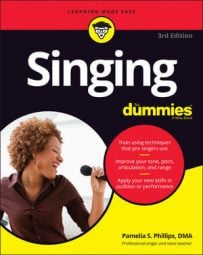How do all those singers project so much sound without microphones? They take advantage of resonance, the vibrations that create tone. Resonance is the glorious magic that allows a singer to fill a large hall with sound without electronic amplification.
Resonance is vibrations that create tone through and within your mouth, throat, and nasal passages. Large, full resonant tones are desirable in some styles of music but inappropriate in other styles. So what’s customary in your favorite style of music?
-
Choral music: If you’re a choral singer, you need resonance so you can be heard when you sing a solo. Use less resonance when you’re asked to blend with other singers.
-
Classical music: Very full resonant tone is desirable in classical music, especially operas. Classical singers try to generate as much resonance as possible to fill the large concert halls when they sing opera. To generate these large resonant tones, you need to really open the space in your throat and the back of your mouth to create a space for the sound to resonate in.
Good breath coordination and precise shapes and sounds of vowels further enhance the resonance. For early classical music, you want resonant tone that’s slightly less than what’s required for the later operas of Puccini, Verdi, or Strauss.
-
Country music: Country music is currently very similar to pop music. Country singers are great storytellers and they often write songs that are very close to speech. They use resonance as they would in speaking — forward and chatty. Early country singers used a lot of twang — forward nasal resonance similar to their speaking voice.
-
Jazz: Jazz singers almost always use a microphone and sing with instruments. When you use a microphone, you don’t have to work so hard to generate resonance to carry your voice to the back of the club. You need to know how to create clear tone and create enough resonance that the microphone picks up your voice.
Musical theater: For this style of singing, you want to create resonance, but not as much as for classical singing. Musical theater singers often wear microphones onstage in productions, so the sound engineer is largely responsible for getting your voice to carry to the back of the hall. If you generate too much resonance, you sound like a classical singer trying to sing musical theater.
Some musical theater roles require a full resonant tone, but classical music requires the most resonance. For musical theater, you want to know how to open the space to generate a lot of resonance when you sing the more legit material (The Light in the Piazza, Maury Yeston’s Phantom, or Rodgers and Hammerstein musicals such as South Pacific or The King and I), and then adjust the space and resonance when you sing contemporary musical theater material that is more conversational (such as In The Heights, Memphis, or Spring Awakening).
-
Pop-rock and R&B: These styles of singing require mostly forward nasal resonance. You need to keep from squeezing the space in the throat and mouth, but you also don’t need to be as fully open as classical singers do. The space may not be as wide open but it should be free of tension. Pop-rock and R&B singers also use a microphone.
If your tone doesn’t have resonance, the microphone will have trouble picking up your sound and projecting it over the instruments. You want enough resonance to sing the style of music, but not as much as classical singers need.

